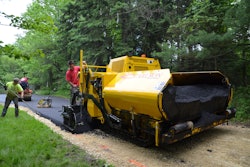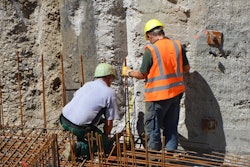
At the National Asphalt Pavement Association (NAPA) annual meeting in San Diego, February 12th, professionals from all areas of the industry offered their insight into what the asphalt market is facing. The result of the discussion clued attendees in to five key areas where the industry is facing challenges and opportunities.
1. Labor
It's no secret that there is a shortage of skilled workers in the industry. Unfortunately, the lack of skilled-workers is not only a problem in the asphalt industry, it’s global, spanning all of the trade professions. Estimates are predicting a shortage of 31 million skilled tradespeople by the year 2020.
Most of this is attributed to the workforce aging out, but some of it is that the construction industry just isn’t appealing enough for the younger generation.
In fact, construction only employs 6% of the millennial workforce in the U.S. The industry’s failure to engage young, hardworking and diverse talent on a broad scale has been a big part of the problems it faces today.
"It’s a challenge we’re all facing," Kevin Kelly, President & CEO of Walsh & Kelly Inc. says. "We had a generation or more of people who were all encouraged to go to college. A lot of these jobs won’t require that. We need to highlight the good life these careers can give."
However, the perception of a rigid work structure mixed with a rugged reputation and old-school mindset haven’t been appealing to the majority of youth, and without them, construction has struggled to keep up with the productivity gains seen in other industries.
James H. Roberts, CEO of Granite Construction, says this is why it's important to get in front of potential workers early.
"Get the initiative started at a young age, even elementary school level," Roberts say. "Support communities, high schools and universities."
Roberts says what's also causing an issue is the wage gap some areas of the industry see.
"Were going to have to create a different wage system if we want to attract people and that’s healthy for the industry," he says. "We’ve depressed the wage rates and until we’re willing to pay a lot more in the industry, which we should do, we’re going to have a skilled labor challenge."
2. Funding
Funding is another issue that is on the mind of every asphalt mix producer and contractor. Yes, The White House officially released a 55-page proposal for President Trump's $1.5 trillion infrastructure plan, but where will this money come from?
The plan includes $200 billion from the federal government. Half of the federal seed money is planned to go toward an incentive program to match financing from state and local governments investing in rebuilding projects. One quarter of the appropriations is set to be used for rural projects in the form of block grant to states.
In addition, $20 billion is set for "transformative programs" for new projects while another $20 billion is allocated to expand the use of loans and private activity bonds. Ten billion is set to go into a "capital financing fund."
The plan is structured around four main goals:
- Generating $1.5 trillion for an infrastructure proposal
- Streamlining the permitting process down to two years
- Investing in rural infrastructure projects
- Advancing workforce training
However, this plan will still require states to foot a lot of the bill, and experts say they should be ready to do that. Since the federal government last raised the gasoline tax at the start of the Clinton administration to 18.4 cents per gallon, 39 states have hiked their at-the-pump fees -- sometimes more than once -- to cover the costs of road construction and maintenance.
"Tax increases are scary for legislatures though," Roberts says "It’s become a total political event but states want money for roads. They aren't voting officials out who are increasing taxes so it’s really a non-issue."
Roberts also says that raising the gas tax wouldn't be a financial issue for the majority of drivers.
"If you drive 20,000 miles a year, your car gets 20 miles per gallon and you pay 12 cents more a gallon with a gas tax increase implemented, that’s a total of $120 a spent more each year."
Many in the industry still believe the FAST act and authorizing a long term Highway Trust Fund is the best way to fund our roads.
"There are principals to Trump's infrastructure plan, but no real money," Kelly says. "The only thing you need to do is put money in the Highway Trust Fund and the FAST act has the principals to be successful, put money there and we’ll be good."
In 2018, the FAST act authorizes a $900 million increase for the construction season. In addition, highways and bridges will receive a portion of the $20 billion over two years (2018-2019) for infrastructure as part of the McConnell-Schumer-Ryan Budget deal.
But the FAST act is set to expire in 2020 which will leave states in uncertainty.
3. Technology
According to the World Economic Forum, in 10 years the construction industry will be almost entirely digitized, with an overall possible savings of $1.2 trillion globally due to increased efficiency and productivity.
"Technology is racing into the construction industry," John Pullen, chief growth officer at Luck Companies says. "Drones, cloud-based aggregators, remote sensing technology, augmented reality and the Internet of Things are all disrupting our industry but also bringing opportunities to it."
However, the industry has to be ready to accept those changes.
"Small companies need to think big," Luck says. "We went to Apple & Google and asked them how to improve our business and they didn't believe there were companies that actually still made rocks. There's a lot you can learn from industries that aren't related to construction and vice-versa."
Pullen says his company is now testing autonomous innovations in his hauling fleet as a result.
Another upside to implementing technology is attracting those younger workers.
"Younger generations want to know you're innovative," Pullen says. "If they see that from the start, they are more willing to consider a career there."
4. Materials
Asphalt paving tons were naturally up 2% in 2017 to about 378 million tons produced. Paving tons are expected to grow in 2018 based on the strength of state highway funding and the commercial/residential markets. The growth in the market will be determined by how much of the $10 billion in the new 2-year budget deal will be allocated to highways and bridges.
However, oil refineries are closing all over the country and that's an unforeseen issue for some producers.
"There are 135 refineries in the U.S. and less than 50 provide significant value to the asphalt industry," Don Wessel GM-Crude & Refined Products Consulting at Poten & Partners says.
This means the industry is having to get materials from fewer sources and finding the ones that are specific to our industry.
5. Trucking
To bring the discussion full circle, the industry is facing a huge challenge in the transportation of materials.
"The biggest issue in our company today is getting our product to the market," Robert says. "We make the material at 56 asphalt plants across the country but then we rely on another company to get the materials out to customers. Running a trucking business is a big deal but having control over the logistics of moving material is important. If it becomes too big of an issue, maybe it’s time to take a closer look at the investment and if it will work for your business."
However, just like skilled construction workers, truck drivers are hard to find. Gaining a CDL is not an easy task and many drivers have lost their licenses due to poor driving decisions.
Still with all the issues facing our industry, the panelists say it's a great time to be in the asphalt industry, but we still have work to do. During the 2007 construction boom, we produced 550 million tons of asphalt. The goal of our industry is to get back to that.
"If we think the 338 million tons we're producing each year now is satisfactory, we have lowered our expectations," Roberts says. "Let's beat 2007!"











![Lee Boy Facility 2025 17 Use[16]](https://img.forconstructionpros.com/mindful/acbm/workspaces/default/uploads/2025/09/leeboy-facility-2025-17-use16.AbONDzEzbV.jpg?ar=16%3A9&auto=format%2Ccompress&fit=crop&h=135&q=70&w=240)








